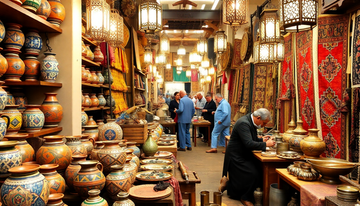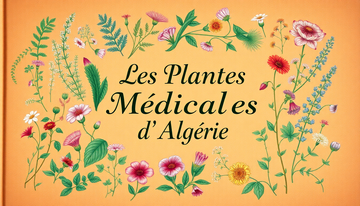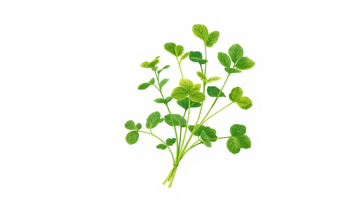Algeria is a country rich in artisanal traditions, reflecting the cultural diversity and creativity of its various regions. From Kabylie to the edges of the Sahara, Algerian craftsmanship is a true treasure, a living testimony to ancestral knowledge passed down through generations. Let us delve into this fascinating world, discovering the wonders of Algerian craftsmanship.
Berber Rugs, Jewels of Algeria
Among the most famous symbols of Algerian craftsmanship, Berber rugs hold a special place. Each region has developed its own signature, from the geometric patterns of Ghardaïa rugs to the vibrant colors of Tlemcen rugs. These textile works are much more than mere floor coverings; they are true art pieces, carrying a rich and ancient symbolism. Traditional weaving techniques, passed down from mother to daughter, give rise to unique pieces, reflecting the cultural identity of their creators.
The Ghardaïa Rug, Desert Reflection
In the oasis of Ghardaïa, women weave rugs with refined geometric patterns inspired by the surrounding desert forms. Each motif holds particular significance, such as the diamond representing fertility or the triangle evoking mountains. Dyed with natural pigments, these rugs are true masterpieces of textile art.
Tlemcen Rugs, Tradition Meets Modernity
The Tlemcen region is renowned for its brightly colored rugs with floral motifs. Ottoman influence is evident, with designs blending tradition and modernity. Tlemcen artisans have preserved their expertise while adapting to contemporary tastes, making their rugs sought after worldwide.
Kabyle Art, an Expression of Identity
Kabylie, the cradle of Berber art, is known for its rich and diverse craftsmanship. From solid silver jewelry to colorful pottery and delicate embroidery, Kabyle art is a true hymn to creativity.
Kabyle Jewelry, Mirrors of the Berber Soul
Kabyle jewelry, often made of silver, is true art. Each piece, meticulously crafted, bears symbolic motifs such as the six-pointed star, crescent moon, or protective eye. These pieces are more than mere ornaments; they are a way to showcase one's belonging to Berber culture.
Kabyle Pottery and Ceramics
Equally remarkable are Kabyle pottery and ceramics, hand-shaped and decorated with geometric or floral patterns. Artisans use ancestral techniques, such as hand modeling or turning, to create unique pieces combining functionality and aesthetics.
Kabyle Textiles, Traditions Woven
Kabyle women are also known for their embroidery and weaving. Haïks, burnouses, and other traditional garments are adorned with symbolic motifs, reflecting the rich textile culture of the region.
Tuareg Crafts, Desert's Imprint
Further south, in the Sahara's depths, Tuareg crafts are distinguished by their intimate connection to the desert environment. From leather goods to gleaming jewelry, each creation bears the mark of this nomadic culture.
Leatherwork, Ancestral Tradition
Leatherwork is a specialty of Tuareg artisans. Bags, sandals, belts, and other accessories are meticulously crafted, using tanning and sewing techniques passed down through generations. Geometric motifs and earthy colors reflect the desert's influence.
Tuareg Jewelry, Reflections of Light
Tuareg jewelry, often made of silver or coral, is genuine masterpieces. Rings, bracelets, and necklaces feature simple forms, highlighting the beauty of the materials. Each piece is a testament to the ingenuity and creativity of nomadic artisans.
Other Forms of Algerian Crafts
Algerian craftsmanship isn't limited to rugs, jewelry, and textiles. Other fascinating traditional skills also deserve to be highlighted.
Basketry and Palm Leaf Work
Basketry and palm leaf work are ancient traditions in Algeria. From baskets to mats, hats to fans, these creations showcase the ingenuity and dexterity of artisans.
Metalwork and Copper Craft
Algeria is also famous for its metalwork, particularly in wrought iron and copper. Lamps, vases, kitchen utensils, and other goldsmithing pieces are crafted with great mastery, reflecting the heritage of ancestral techniques.
Wood and Stone Carving
Finally, Algerian craftsmanship is distinguished by its carved creations, whether in wood or stone. Statuettes, decorative objects, and traditional furniture are all testimonies to the skill of artisans.
Ottoman Heritage in Algerian Crafts
Algeria has also been marked by the influence of the Ottoman Empire, leaving an indelible mark on local craftsmanship. This fusion of traditional and Ottoman styles has given rise to unique creations, blending Eastern motifs with ancestral techniques.
Ottoman Influence on Motifs and Techniques
Floral motifs, arabesques, and calligraphies typical of Ottoman art gradually integrated into Algerian craft creations. Similarly, techniques like hammered copperwork were adopted and adapted by local artisans.
Fusion of Traditional and Ottoman Styles
This meeting of Berber heritage and Ottoman influence has produced rich and diverse craftsmanship, reflecting Algeria's complex identity. Artisans skillfully combined ancestral traditions with external influences, creating a uniquely Algerian craft.
Transmission and Preservation of Know-How
Algerian craftsmanship is not only a cultural heritage but also a social bond and economic development vector. Artisans play an essential role in preserving and transmitting these ancestral techniques.
Artisans' Role in Algerian Society
Beyond their creative talent, Algerian artisans are key actors in their community's social and economic life. They contribute to the valorization of local cultural identity and participate in maintaining the social fabric.
Preservation Initiatives for Ancestral Techniques
Facing globalization challenges, many initiatives have emerged to preserve traditional craft techniques. Training programs, cooperatives, and quality labels support artisans and help transmit their know-how to future generations.
Algerian Crafts Today
Far from being a relic of the past, Algerian craftsmanship is alive and adapting to market changes. From traditional markets to international distribution channels, Algerian craft creations gain recognition and visibility.
Traditional Markets and Souks, Craft Showcases
Traditional markets and souks remain essential places to discover the richness of Algerian craftsmanship. Here, artisans display and sell their creations, perpetuating ancestral traditions.
Export and International Recognition
Thanks to the quality and authenticity of their products, Algerian artisans conquer new international markets. Their creations are increasingly sought after, reflecting the value and uniqueness of Algerian craftsmanship.
Fair Trade and Sustainable Development in Crafts
Finally, many initiatives promote fair and sustainable craftsmanship, respectful of the environment and local communities. These approaches value artisans' work and contribute to the economic development of regions.
Conclusion
Algerian craftsmanship is a treasure, reflecting the country's cultural diversity and creativity. From Berber rugs to Tuareg jewelry, Kabyle textiles to metal objects, each creation bears the mark of ancestral know-how passed down through generations. Far from being just a heritage of the past, this craftsmanship is alive and adapting to changes while preserving its authenticity. Supporting and valuing Algerian craftsmanship is a celebration of the cultural identity of a country rich in traditions and talents.






